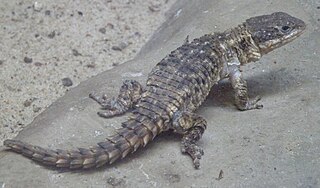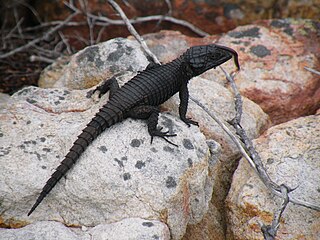
The genus Cordylus includes a wide variety of species of small to medium spiny lizards from Africa, collectively called girdle-tailed lizards or girdled lizards. All are diurnal and ovoviviparous. Most species are rupicolous (rock-dwelling), while a few species are arboreal or live in burrows. They defend themselves with osteoderms and by quickly retreating into rock crevices or burrows. Many species live in groups, and males defend territories.

The armadillo girdled lizard, also commonly known as the armadillo lizard, the armadillo spiny-tailed lizard, and the golden-armadillo lizard, is a species of lizard in the family Cordylidae. The species is endemic to desert areas along the western coast of South Africa. In 2011, it was moved to its own genus based on molecular phylogeny, but formerly it was included in the genus Cordylus.

The sungazer, also known as the giant girdled lizard, giant dragon lizard, ouvolk, or giant zonure, is the largest species of the Cordylidae, a family of lizards from sub-Saharan Africa. This threatened species is endemic to Highveld grasslands in the interior of South Africa. In 2011, it was assigned to the new genus Smaug, along with seven other species previously belonging to the genus Cordylus, based on a comprehensive molecular phylogeny of the Cordylidae.
Lawrence's girdled lizard is a species of lizard in the family Cordylidae. The species is endemic to South Africa.

The Sekukhune flat lizard is a species of lizard in the family Cordylidae. The species is endemic to South Africa. It has two subspecies.

The Limpopo girdled lizard, also known commonly as Jones's armadillo lizard and Jones's girdled lizard, is a species of lizard in the family Cordylidae. The species is endemic to Southern Africa.

The Transvaal girdled lizard or Reichenow's spiny-tailed lizard is a very flattened girdled lizard from northeastern South Africa, Eswatini, and southeastern Botswana. It prefers rock outcrops in open grassland and feeds on small arthropods, especially beetles.

Warren's girdled lizard is a species of relatively large, flattened lizard in the family Cordylidae. The species is native to Southern Africa.

Cordylus niger, the black girdled lizard, is a medium-sized lizard restricted to Table Mountain on the Cape Peninsula and a second, isolated population near Langebaan.

Cordylus cordylus, the Cape girdled lizard, is a medium-sized lizard indigenous to the southern Cape region of South Africa, where it inhabits crags, rocky outcrops and mountain summits. They evade predators by wedging themselves firmly in rock cracks.

Ninurta coeruleopunctatus, the blue-spotted girdled lizard or simply blue-spotted lizard, is a monotypic genus that is endemic to southern, coastal South Africa.
Namazonurus campbelli, commonly known as Campbell's girdled lizard, is a species of lizard in the family Cordylidae. A small girdled lizard, N. campbelli is endemic to Namibia. It is often mistaken for the more common Herero girdled lizard, N. pustulatus, as they both are similar in size and have flattened bodies. N. campbelli lives in rock crevices and cracks on dry mountain slopes

Smaug is a genus of lizards in the family Cordylidae. The genus Smaug is a group of species of spiny southern African lizards, separated from the genus Cordylus in 2011 on the basis of a comprehensive molecular phylogeny of the Cordylidae. The type species is the giant girdled lizard, S. giganteus.

Van Dam's girdled lizard is a species of lizard in the family Cordylidae. The species is endemic to South Africa.

Karusasaurus, commonly known as Karusa lizards, is a genus of lizards in the family Cordylidae.

Namazonurus, is a genus of lizards, commonly known as Namaqua girdled lizards, in the family Cordylidae. The genus contains five species, which are endemic to southern Africa, and feed on insects and small vertebrates.

Smaug breyeri, also known commonly as the Waterberg dragon lizard or the Waterberg girdled lizard, is a species of lizard in the family Cordylidae. The species is endemic to South Africa.

The Rooiberg girdled lizard is a species of lizard in the family Cordylidae. It is a small, spiny lizard found in South Africa.
The western dwarf girdled lizard is a species of lizard in the family Cordylidae. It is a small, spiny lizard found in South Africa.

Oelofsen's girdled lizard is a species of lizard in the family Cordylidae. It is a small, spiny lizard found in South Africa.

















